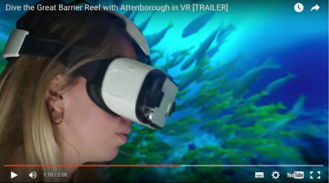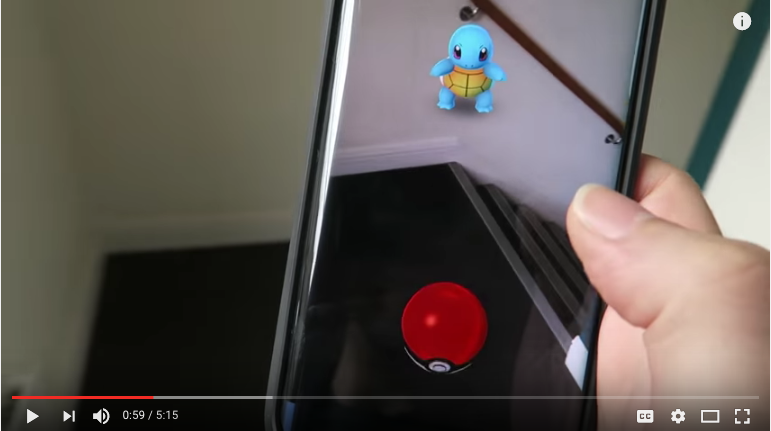Pokemon Go. Explain.
Pokémon Go—the augmented reality game—is the latest phenomenon driving marketers crazy. Find out the difference between AR and VR, why Pokémon Go is the hottest app in the world, and how to market through the craze.
Pokémon Go is the latest phenomenon that is driving marketers crazy. What is it, why should I care, is this important to me?
What Is It?
Pokémon Go is the hottest app in the world at the moment. It is an augmented reality game where players try to catch Pokémon. The cool part is that you “see” the Pokémon via your smartphone's camera.
Installing #PokemonGo! Walk to work is about to get a lot more interesting… pic.twitter.com/cqBBscj1v4
— Katie Bradburn (@katie_bradburn) July 14, 2016
It's Geocaching, Google Maps, and Second Life rolled into one game—but WAY bigger and more mainstream than geocaching or Second Life.
Like with geocaching, players hunt for items hidden at a particular location. It's a real-world outdoor treasure hunt using GPS. In the case of Pokémon Go, players go to destinations and check for Pokémon to capture (it's also fun to snap photos of Pokémon and share them online because it's silly).
There's a bloody #Pokemon in the Radio X studio!@philclifton #pokemongo pic.twitter.com/5Pcbm68vuD
— Radio X (@RadioX) July 14, 2016
There are destinations called “gyms”, which are battlegrounds for players who reach a certain level in the game. But for beginner players, the majority of the game is about walking around in the real world and catching these virtual critters (like geocaching but finding virtual things instead of physical things).
Players use maps based on Google Maps and walk around (yes, in the world, not sitting on their couch) and they look for Pokémon through their phone's camera lens.
Pokémon Go is like Victorians looking for fairies.
And where Second Life was a player-created world, the world of Pokémon Go overlays its imaginary world on the real-world. Your character walks around in a virtual world (based on you walking in the real world) and, when you spot a Pokémon, you see the Pokémon overlayed on the real world and throw PokeBalls at it to capture it.
What the what? I know. It's actually very simple. Find Pokémon, throw things at it, catch it, feed it candy. Meet random strangers doing the same.
The stats are amazing with reports of the game's active daily users surpassing Twitter, Snapchat, and even Facebook. (Source: CNET)
Business Insider reports that SensorTower data shows $1.6 million in daily revenue is being generated from in-app purchases.
It is a cultural phenomenon, not simply a hot app, which is why it is worth your attention. Think of it as the coming out party for augmented reality.
Explain to me Augmented Reality vs Virtual Reality
Here's my 1 minute marketing tip on AR, VR & Pokemon Go.
Augmented reality (AR) technology creates a layer of computer-generated enhancements on top of an existing reality. If you use Snapchat, the filters that apply a mask to your face are an example of augmented reality.
AR is part of lots of apps and it is a cool enhancement that blends digital and real-world components. L'Oreal Makeup Genius app is another example that lets users apply various make-up techniques and then make in-app purchases of real products.
Virtual reality (VR) is different and usually requires some type of headset or visual/audio aid. VR is an artificial, computer-generated simulation environment where the user is immersed in that world through simulations to their vision and hearing.
David Attenborough's film Great Barrier Reef is an amazing example of VR, and it gives viewers the experience of diving.

Imagine the applications in medical training where doctors can have an immersive learning experience for surgical techniques or can help patients overcome phobias.
A limited, but easy to understand, way to think about AR vs VR is:
25% Virtual + 75 % Real = Augmented Reality
75% Virtual + 25 % Real = Virtual Reality
Why Should I Care
Pokémon Go has an estimated 9-15 million active daily users in the US. It's officially released in the US, Australia and New Zealand but people around the world have figured out hacks to download and play the game in their own city.
That's a lot of people wandering around, in real life, who might be passing by your business. They are happy and having fun, which means it is a perfect time to create a positive association between them and your brand.
Inc.com has a has a great list of Pokemon Go tips for business.
Here's what I would do if I was a bookseller or librarian:
If your location is near a PokeStop (a place where players stock up on PokeBalls and other accessories) or a Gym (a place players go to train their Pokemon and battle others) then take advantage of the increase in foot traffic by offering players something.
That could be as simple as a refreshment or coupon, making your bathroom available to the public, putting up a poster acknowledging players in the area, using #Pokémongo and #Pokémon hashtags on social media, or asking players to post and tag their activity at your location.
- Crystal Bridges Museum of American Art snapped photos of Pokemon next to pieces of art and blogged about it as a way to draw in the crowds.
- If you're a library, community centre or workout studio, drop a lure before popular events or programmes and invite people in for a free class.
- My friend Darren Barefoot suggested, “If I worked for an NGO, I'd put a sign outside our location saying 'Did you catch a Pokemon near us? Celebrate by making a donation!'”
If you do any Facebook advertising, then try some advertising using the in-app purchase of “Lures”. Dropping a lure attracts Pokémon and their capturers. Think of it as a fishing lure. Apparently it's incredibly cheap to buy a lure. If your business is near a PokeStop, give it a try and have an offer or special deal for players descending on your location.
If you're not located near a PokeStop or gym, then go where the Pokémon roam. Organize a photo walk, or Go walk, meet other players, pass out something cool related to Pokemon.
- Create a Pokemon-inspired drink or menu item to show you're in on the game.
- Sponsored locations can't be far off given the popularity and potential advertising revenue.
- Have a product even tangentially related? Mention Pokemon in your promotions. If I sold mobile phone chargers and external battery chargers then I'd be all over this opportunity. Go is a hog on battery life.
Can't stand it? Throw some stardust and offer people a retreat from the hectic Pokemon catching.
Who Cares?
Are you playing Go? Plenty of people are and it's mostly adults, not kids, so here's where it becomes interesting for marketing.
Who's actually playing this game? Certainly there's a nostalgia factor for the 20 to 30 somethings who played the original games and dreamed of running around their neighbourhood and catching Pokemon in real life. But the same way that everyone knows about Harry Potter, whether they read the books or not, people know of Pokemon, and that's attracting a lot of adult players who never played the earlier games.
If you're skeptical about the passion people have for the Go, read the comments on this Gizmodo post.
Not Playing But Want to Have a Look?
This guy has a nice quick walkthrough
https://www.youtube.com/watch?v=VYTXQVteV6M
Related Reads
http://www.inc.com/walter-chen/pok-mon-go-is-driving-insane-amounts-of-sales-at-small-local-businesses-here-s-h.html
http://www.cbc.ca/news/trending/pokemon-go-obsession-explained-who-what-why-how-1.3673279



